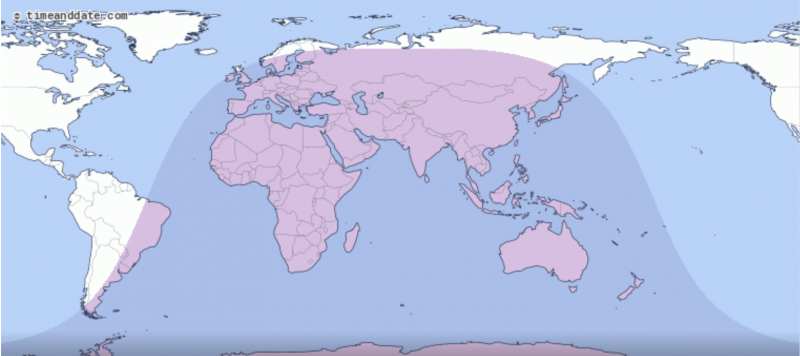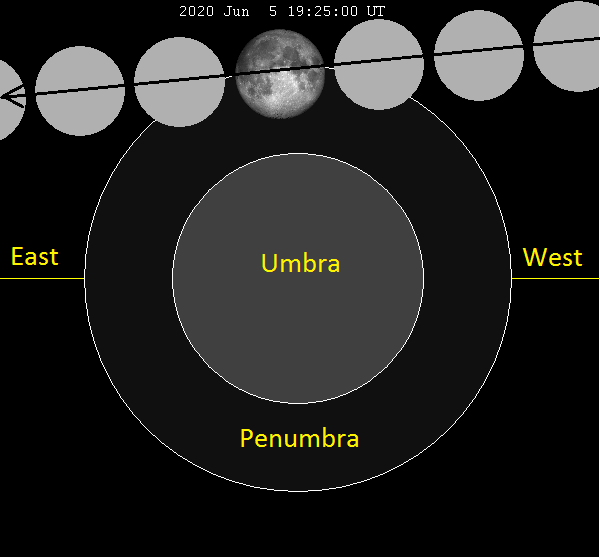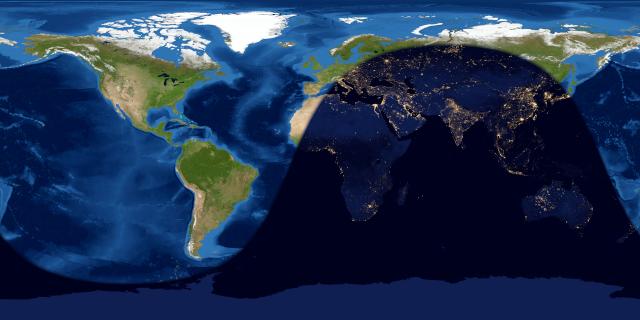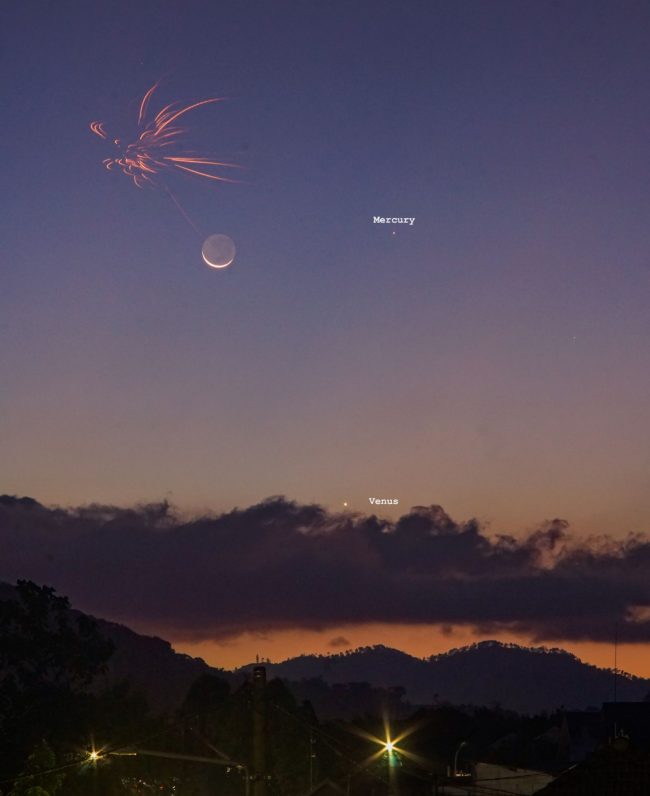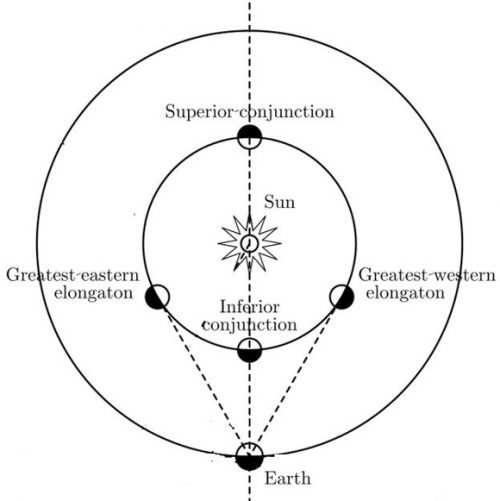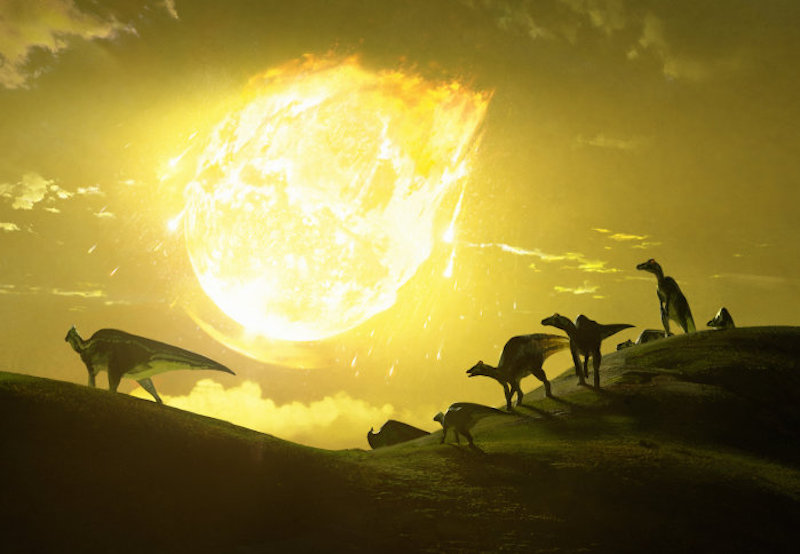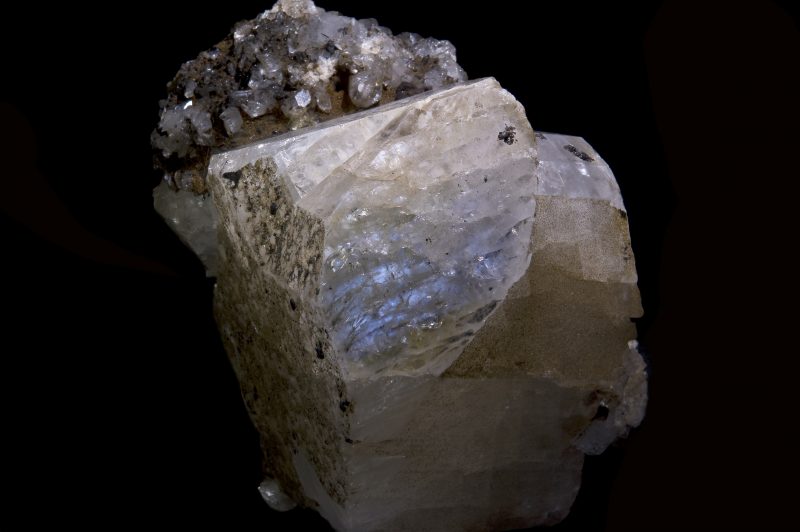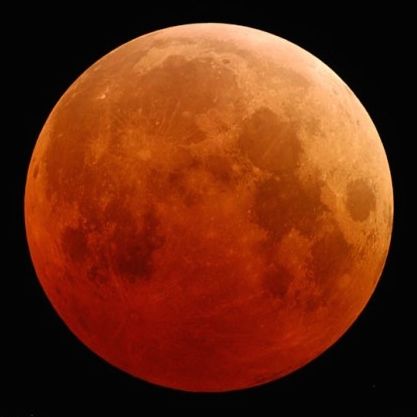
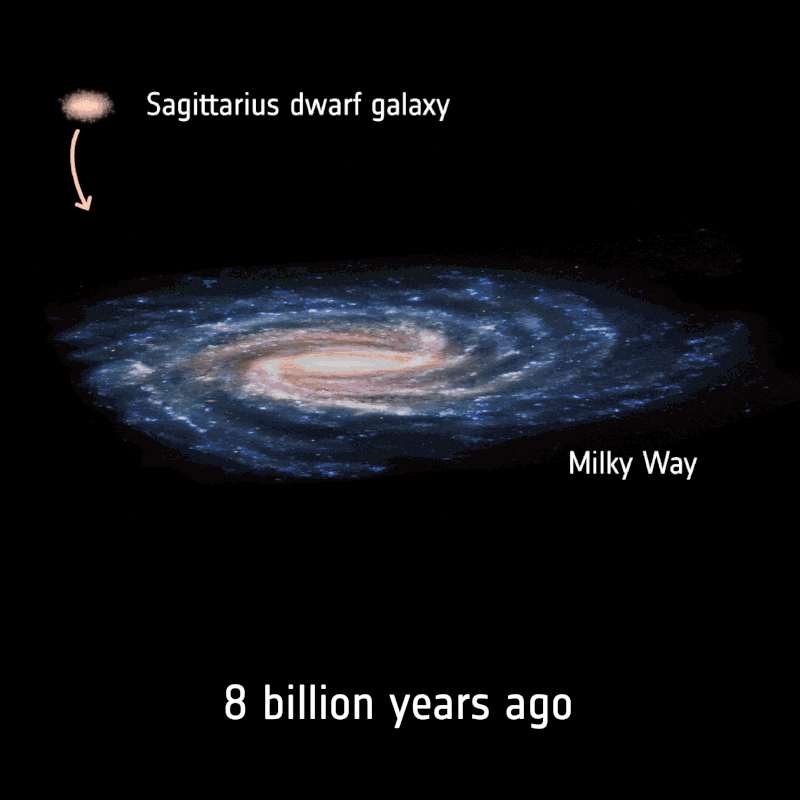
The Sagittarius dwarf galaxy has been orbiting the Milky Way for billions for years. As its orbit around the 10,000 times more massive Milky Way gradually tightened, it started colliding with our galaxy’s disk. The three known collisions between Sagittarius and the Milky Way have, according to a new study, triggered major star formation episodes, one of which may have given rise to the solar system. Image via ESA.
Via European Space Agency (ESA)
The formation of the sun, the solar system and the subsequent emergence of life on Earth may be a consequence of a collision between our galaxy, the Milky Way, and a smaller galaxy called Sagittarius, discovered in the 1990s to be orbiting our galactic home. That’s according to a new study published May 25, 2020, in the peer-reviewed journal Nature Astronomy.
Astronomers have known that Sagittarius repeatedly smashes through the Milky Way’s disk, as its orbit around the galaxy’s core tightens as a result of gravitational forces. Previous studies suggested that Sagittarius, a so-called dwarf galaxy, had had a profound effect on how stars move in the Milky Way. Some astronomers even claim that the 10,000 times more massive Milky Way’s trademark spiral structure might be a result of the at least three known crashes with Sagittarius over the past six billion years.
The new study, based on data gathered by ESA’s galaxy mapping Gaia spacecraft, revealed for the first time that the influence of Sagittarius on the Milky Way may be even more substantial. The ripples caused by the collisions seem to have triggered major star formation episodes, one of which roughly coincided with the time of the formation of the sun some 4.7 billion years ago.
Astrophysicist Tomás Ruiz-Lara of the Instituto de Astrofísica de Canarias in Tenerife, Spain, is lead author of the study. He said in a statement:
It is known from existing models that Sagittarius fell into the Milky Way three times – first about five or six billion years ago, then about two billion years ago, and finally one billion years ago.
When we looked into the Gaia data about the Milky Way, we found three periods of increased star formation that peaked 5.7 billion years ago, 1.9 billion years ago and 1 billion years ago, corresponding with the time when Sagittarius is believed to have passed through the disk of the Milky Way.
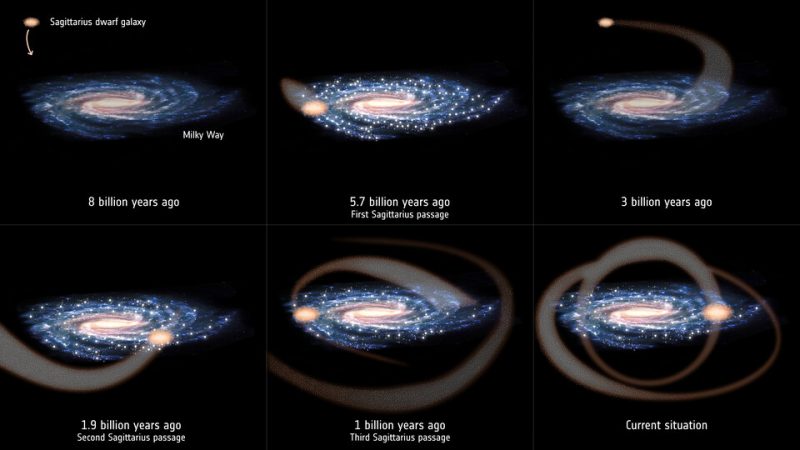
The Sagittarius dwarf galaxy has been orbiting the Milky Way for billions for years. As its orbit around the 10,000 times more massive Milky Way gradually tightened, it started colliding with our galaxy’s disk. The 3 known collisions between Sagittarius and the Milky Way have, according to a new study, triggered major star formation episodes, one of which may have given rise to the solar system. Image via ESA.
Ripples on the water
The researchers looked at luminosities, distances and colors of stars within a sphere of about 6,500 light-years around the sun and compared the data with existing stellar evolution models. According to Ruiz-Lara, the notion that the dwarf galaxy may have had such an effect makes a lot of sense. He said:
At the beginning you have a galaxy, the Milky Way, which is relatively quiet. After an initial violent epoch of star formation, partly triggered by an earlier merger as we described in a previous study, the Milky Way had reached a balanced state in which stars were forming steadily. Suddenly, you have Sagittarius fall in and disrupt the equilibrium, causing all the previously still gas and dust inside the larger galaxy to slosh around like ripples on the water.
In some areas of the Milky Way, these ripples would lead to higher concentrations of dust and gas, while emptying others. The high density of material in those areas would then trigger the formation of new stars. Carme Gallart, also of the Instituto de Astrofísica de Canarias, is a co-author of the paper. Gallart said:
It seems that not only did Sagittarius shape the structure and influence the dynamics of how stars are moving in the Milky Way, it has also led to a build-up of the Milky Way. It seems that an important part of the Milky Way’s stellar mass was formed due to the interactions with Sagittarius and wouldn’t exist otherwise.
The birth of the sun
In fact, it seems possible that even the sun and its planets would not have existed if the Sagittarius dwarf had not gotten trapped by the gravitational pull of the Milky Way and eventually smashed through its disk. Gallart said:
The sun formed at the time when stars were forming in the Milky Way because of the first passage of Sagittarius. We don’t know if the particular cloud of gas and dust that turned into the sun collapsed because of the effects of Sagittarius or not. But it is a possible scenario because the age of the sun is consistent with a star formed as a result of the Sagittarius effect.
Every collision stripped Sagittarius of some of its gas and dust, leaving the galaxy smaller after each passage. Existing data suggest that Sagittarius might have passed through the Milky Way’s disk again quite recently, in the last few hundred million years, and is currently very close to it. In fact, the new study found evidence of a recent burst of star formation, suggesting a possible new and ongoing wave of stellar birth.
Bottom line: A new study suggests that the formation of the sun and the solar system may be a consequence of a collision between our Milky Way galaxy and a smaller galaxy called Sagittarius.
Source: The recurrent impact of the Sagittarius dwarf on the Milky Way star formation history
from EarthSky https://ift.tt/30e6kdQ


The Sagittarius dwarf galaxy has been orbiting the Milky Way for billions for years. As its orbit around the 10,000 times more massive Milky Way gradually tightened, it started colliding with our galaxy’s disk. The three known collisions between Sagittarius and the Milky Way have, according to a new study, triggered major star formation episodes, one of which may have given rise to the solar system. Image via ESA.
Via European Space Agency (ESA)
The formation of the sun, the solar system and the subsequent emergence of life on Earth may be a consequence of a collision between our galaxy, the Milky Way, and a smaller galaxy called Sagittarius, discovered in the 1990s to be orbiting our galactic home. That’s according to a new study published May 25, 2020, in the peer-reviewed journal Nature Astronomy.
Astronomers have known that Sagittarius repeatedly smashes through the Milky Way’s disk, as its orbit around the galaxy’s core tightens as a result of gravitational forces. Previous studies suggested that Sagittarius, a so-called dwarf galaxy, had had a profound effect on how stars move in the Milky Way. Some astronomers even claim that the 10,000 times more massive Milky Way’s trademark spiral structure might be a result of the at least three known crashes with Sagittarius over the past six billion years.
The new study, based on data gathered by ESA’s galaxy mapping Gaia spacecraft, revealed for the first time that the influence of Sagittarius on the Milky Way may be even more substantial. The ripples caused by the collisions seem to have triggered major star formation episodes, one of which roughly coincided with the time of the formation of the sun some 4.7 billion years ago.
Astrophysicist Tomás Ruiz-Lara of the Instituto de Astrofísica de Canarias in Tenerife, Spain, is lead author of the study. He said in a statement:
It is known from existing models that Sagittarius fell into the Milky Way three times – first about five or six billion years ago, then about two billion years ago, and finally one billion years ago.
When we looked into the Gaia data about the Milky Way, we found three periods of increased star formation that peaked 5.7 billion years ago, 1.9 billion years ago and 1 billion years ago, corresponding with the time when Sagittarius is believed to have passed through the disk of the Milky Way.

The Sagittarius dwarf galaxy has been orbiting the Milky Way for billions for years. As its orbit around the 10,000 times more massive Milky Way gradually tightened, it started colliding with our galaxy’s disk. The 3 known collisions between Sagittarius and the Milky Way have, according to a new study, triggered major star formation episodes, one of which may have given rise to the solar system. Image via ESA.
Ripples on the water
The researchers looked at luminosities, distances and colors of stars within a sphere of about 6,500 light-years around the sun and compared the data with existing stellar evolution models. According to Ruiz-Lara, the notion that the dwarf galaxy may have had such an effect makes a lot of sense. He said:
At the beginning you have a galaxy, the Milky Way, which is relatively quiet. After an initial violent epoch of star formation, partly triggered by an earlier merger as we described in a previous study, the Milky Way had reached a balanced state in which stars were forming steadily. Suddenly, you have Sagittarius fall in and disrupt the equilibrium, causing all the previously still gas and dust inside the larger galaxy to slosh around like ripples on the water.
In some areas of the Milky Way, these ripples would lead to higher concentrations of dust and gas, while emptying others. The high density of material in those areas would then trigger the formation of new stars. Carme Gallart, also of the Instituto de Astrofísica de Canarias, is a co-author of the paper. Gallart said:
It seems that not only did Sagittarius shape the structure and influence the dynamics of how stars are moving in the Milky Way, it has also led to a build-up of the Milky Way. It seems that an important part of the Milky Way’s stellar mass was formed due to the interactions with Sagittarius and wouldn’t exist otherwise.
The birth of the sun
In fact, it seems possible that even the sun and its planets would not have existed if the Sagittarius dwarf had not gotten trapped by the gravitational pull of the Milky Way and eventually smashed through its disk. Gallart said:
The sun formed at the time when stars were forming in the Milky Way because of the first passage of Sagittarius. We don’t know if the particular cloud of gas and dust that turned into the sun collapsed because of the effects of Sagittarius or not. But it is a possible scenario because the age of the sun is consistent with a star formed as a result of the Sagittarius effect.
Every collision stripped Sagittarius of some of its gas and dust, leaving the galaxy smaller after each passage. Existing data suggest that Sagittarius might have passed through the Milky Way’s disk again quite recently, in the last few hundred million years, and is currently very close to it. In fact, the new study found evidence of a recent burst of star formation, suggesting a possible new and ongoing wave of stellar birth.
Bottom line: A new study suggests that the formation of the sun and the solar system may be a consequence of a collision between our Milky Way galaxy and a smaller galaxy called Sagittarius.
Source: The recurrent impact of the Sagittarius dwarf on the Milky Way star formation history
from EarthSky https://ift.tt/30e6kdQ



